Vintage Ads: Mid-Century Travel by Boat, Bus, Plane, and Train
Airlines, railroads, buses were all eager for Americans to reach their vacation destinations using their services. These advertisements from the mid-century did their best to lure travelers with promises of luxury, safety, speed, and value.
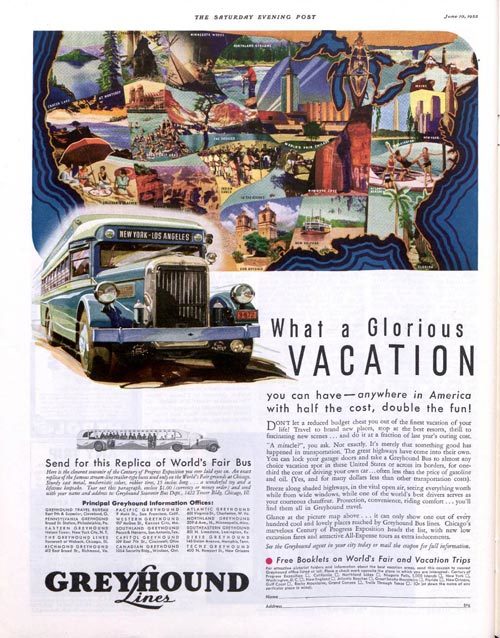
June 10, 1933
“What a glorious vacation you can have — anywhere in America with half the cost, double the fun!”
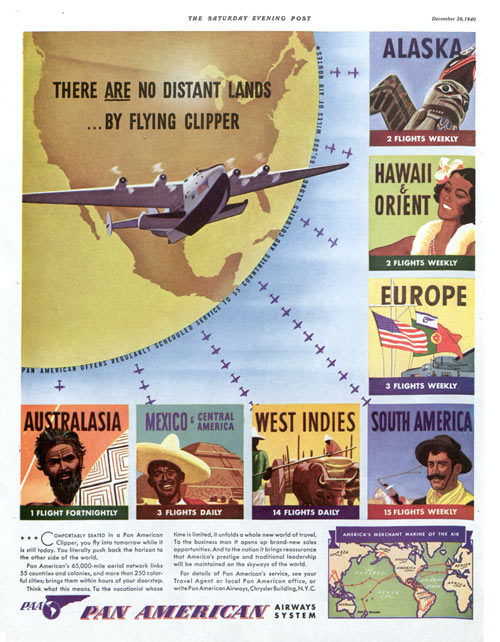
December 28, 1940
“Comfortably seated in a Pan American Clipper, you fly into America while it is still today. You literally push back the horizon to the other side of the world.”

March 9, 1946
“As soon as summer arrives — and with rail conditions greatly improved — we’ll be looking for you.”

September 21, 1946
“Swiftly your Constellation soars outward, swiftly over the rim of the North Atlantic, now racing with the turn of the earth — St. Malo off the starboard wingtip and Paris — proud Paris — on the horizon.”

November 2, 1946
“You can plan for it now — the Orient! It is bigger and more beautiful and stranger than other places in the world.”

November 30, 1946
“Here in the land of perennial Spring, you enjoy special pleasures that are rare indeed the earth around — at its gay fiestas, stirring bullfights, smart Mediterranean resorts.”
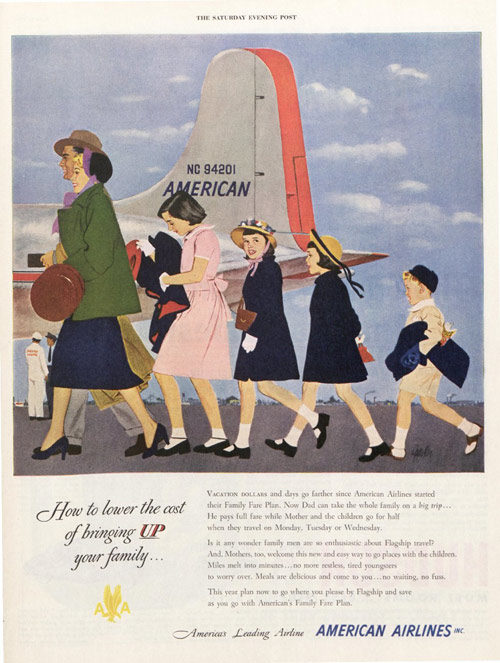
April 22, 1950
“Now Dad can take the family on a big trip…He pays full fare while Mother and the children go for half when they travel Monday, Tuesday or Wednesday.”
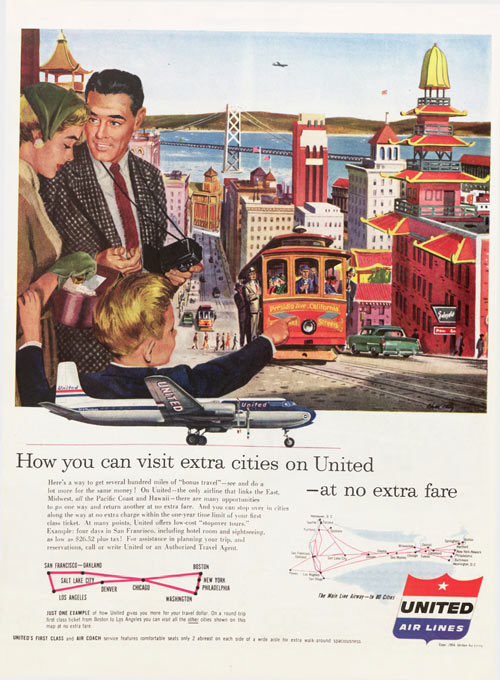
April 17, 1954
“At many points, United offers low-cost ‘stopover tours.’ Example: four days in San Francisco, including hotel and sightseeing, as low as $26.52 plus tax!”
Vintage Ads: Ivory Soap
Ivory Soap was first sold by Procter & Gamble in 1879, and it’s still available today, nearly 140 years later. The Saturday Evening Post has regularly carried Ivory ads throughout its equally long history. While the tactics have changed (one early ad warned Europe-bound travelers to bring their own soap), the basic message never did: Ivory was always “The Soap that Floats” and “99 44/100% Pure.”
(All advertisements copyright © Procter & Gamble)

“It is a mistake to suppose that you can buy good soap ‘anywhere in Europe.’”

“There are two things she will do well to remember: (1.) All men enjoy good meals. (2.) Most men appreciate cleanliness.”

“Professional florists use Ivory Soap in preference to anything else.”

“After a hard hike or muscle-building romp, it certainly will be a pleasure for him to have an old-time bath with the bubbling, copious Ivory lather as he used to have at home.”

“With Ivory as their guardian all through the day, your hands can say nice things about you always!”

“I don’t have $780 a year to spend on a maid—like my nice next-door neighbor, Alice G, who has two cars and never even washes out a handkerchief!”

“Most men (and most wives might as well know it) warble more cheerfully, relax more completely, in the clean-smelling foam of an Ivory bath—with a big, mansized cake of Ivory, floating in easy reach.”

“When you take a healthy dive into a brimming Ivory bath . . . And lather up with great rich gobs of pure, pure, Ivory lather . . . Then . . .You’re washing blues and troubles and worries away.”

“If you want a baby-clear, baby-smooth skin, use the baby’s beauty treatment.”

“Recently a leading medical journal wrote every doctor in the United States asking which soap they advised. For both babies’ and grown-ups’ skin, more doctors replied “Ivory” than any other brand of toilet soap.”
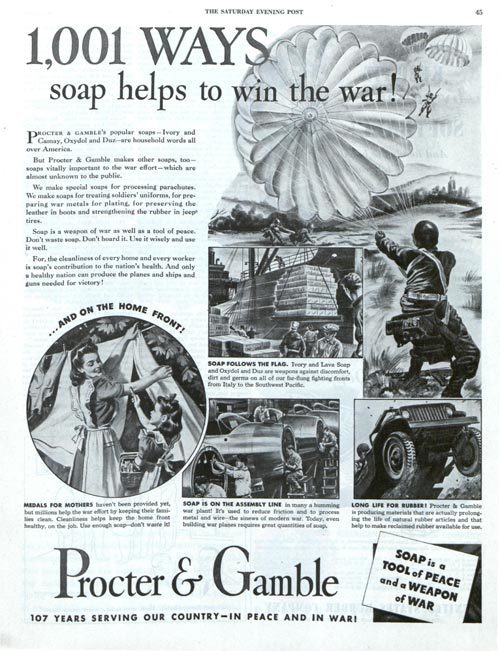
“We make special soaps for processing parachutes. We make soaps for treating soldiers’ uniforms, for preparing war metals for plating, for preserving the leather in boots and strengthening the rubber in jeep tires.”
Vintage Ads: Let Them Eat Yeast?

For decades, homemakers used fresh yeast to make their family’s bread. But yeast sales plummeted in the 1910s as busy Americans started buying bread at grocery stores. To boost sagging sales, Fleischmann’s Yeast promoted yeast as a health food. They claimed it was an important source of vitamins, which had only recently been discovered. It could also cure constipation, bad breath, acne, boils, and sluggishness and could ensure “internal cleanliness.” Fleischmann’s recommended drinking a half-ounce yeast cake dissolved in water three times a day.
Of all the wild claims, none was as outrageous as the assertion in a 1921 ad that yeast was “very palatable nibbled from the cake. Spread with butter on crackers, toast or bread, it is delicious.”
By the 1930s, the Federal Trade Commission stepped in to ask why none of the doctors featured in the ads practiced in America. And what exactly was “internal fatigue” — a symptom claimed to be cured by yeast? Fleischmann’s eventually bowed to pressure to produce more responsible ads, but not before its “Yeast for Health” campaign had increased its sales 1,000 percent.
This article is featured in the July/August 2018 issue of The Saturday Evening Post. Subscribe to the magazine for more art, inspiring stories, fiction, humor, and features from our archives.
The Rockwell Files: Pain in the Rear

When Norman Rockwell was planning this iconic Post cover, he spent a certain amount of time considering how much of the boy’s derriere to show.
Too much cheek would be considered rude, and too little wouldn’t be funny. He discussed it with friends and family and finally settled for this half-up, half-down compromise.
Later that same year, the same young model, Eddie Locke, would pose alongside a state policeman for Rockwell’s Runaway cover.
As an adult, Eddie was asked what his boyhood friends thought of his modeling for the Post.
“You know,” he replied, “when you’re sitting with a police officer, that’s one thing. When you’re posing with your pants down, that’s quite another.”
Driverless Cars and Flat TVs: Predictions of an Automated Future in 1956

The idea of a driverless car must have seemed fantastic to Post readers when this ad appeared in 1956. Yet America’s Independent Power Companies, the advertiser, predicted they’d be a reality some day.
The ad gets many other things right: More than a decade before the invention of the microwave, it anticipated cooking food in seconds. It also predicted light sensors that automatically switch on lamps after dark, television screens that hang on the wall, and “electric heat pumps will use outside air to cool your house in summer, heat it in winter.”
Lastly, the ad claimed that the electric light and power companies were expecting the demand for electricity to double in 20 years. In this regard, they were wrong; it more than tripled.
Cover Collection: High-Fashion Hats for the Kentucky Derby
Long before most of us were old enough to know what a horse was (let alone a mint julep), Post ladies were dazzling us with their chapeaus.
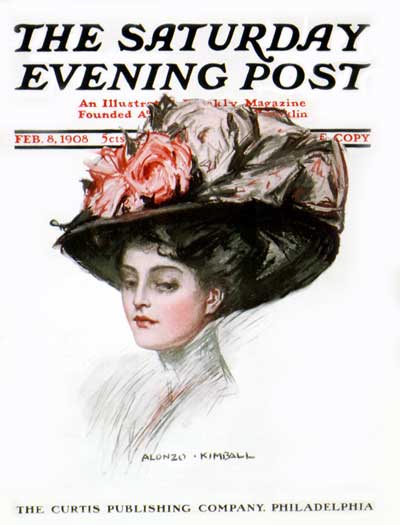
by Alonzo Kimball
February 8, 1908
This pretty lady was quite a standout in 1908, with a hat large enough to serve as shade for three. This one must have required several hatpins to secure.
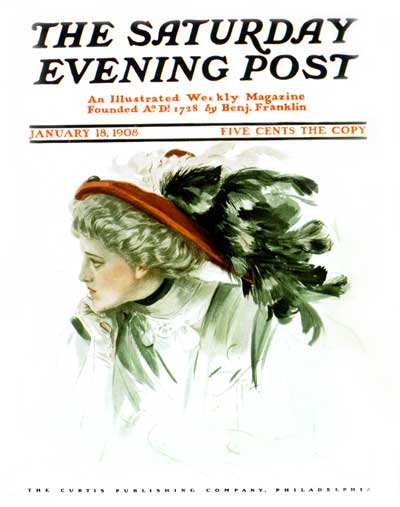
by Harrison Fisher
January 18, 1908
Harrison Fisher was an artist who graced many Post covers with lovely ladies. This hat requires a profile view for best effect. One wonders what poor bird(s) suffered for this work of art. Well, they say beauty has its price.

by Harrison Fisher
5/21/10
There are dozens of Post “hat ladies” to choose form, but we couldn’t resist this gorgeous paisley turban. This was also painted by artist Harrison Fisher. We love the color reproduction for 1910.

by Harrison Fisher
November 25, 1911
Let’s hope that fancy motor car doesn’t get up too much speed! Somewhere between glamorous and…well, crazy, these hats make a fashion statement…of some kind. Luckily there was still room in the car for the dog.
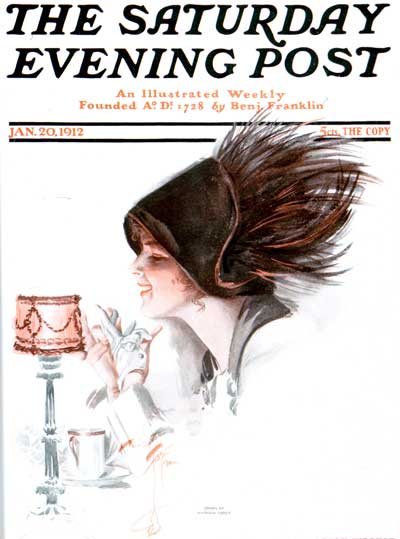
by Harrison Fisher
January 20, 1912
Artist Harrison Fisher must have done some serious hat shopping. In “Coffee and Conversation” from 1912, this lady’s headgear is bound to turn some heads. We kind of see Lady Gaga going for this one.

by Penrhyn Stanlaws
March 24, 1928
Thank goodness for Derby Ladies! Where else can we drool over these beautiful hats these days? Such as this simply elegant cover from 1928.

by Alfred Panepinto
August 21, 1937
It’s Derby Day! Make sure to bring your binoculars so you can watch your favorite pony round the track.
Descriptions courtesy of Diana Denny.
Norman Rockwell Paints That First Roof Antenna

One of Rockwell’s favorite themes was the past confronting the future. In this November 5, 1949, cover, he captures the happy moment when a new TV owner finally sees a picture on his set. The modern reader cannot imagine how happy new TV owners were just to see a blurry, flickering black-and-white image. And how many among us know the challenge of mounting an antenna on the roof?
Rockwell highlights the wonder of this new technology by showing its arrival in the old home of an elderly gentleman. The gabled roof line indicates the house was built sometime in the previous century, its age emphasized by the faded paint, the gable decoration that has lost its spindles over the years, and the weathered, cracked shingles. Notable are the gent’s red-gartered sleeves, a fashion dating to the 1890s. Dressed for the 19th century, he’s welcoming the 20th into his living room.
Cover Collection: Bad Neighbors
The 1950s and ’60s were a time of conformity, right? Well, leave it to Post cover artists to find the odd ones.

Thornton Utz
May 2, 1953
The way Harry figures it, you can spend all summer planting, mowing, and watering—or you can just paint the dadgum patio green and relax in your hammock for the duration of nice weather. Admit it, you wish you had thought of it. This was by cover artist Thornton Utz, who apparently had a thing about yardwork.
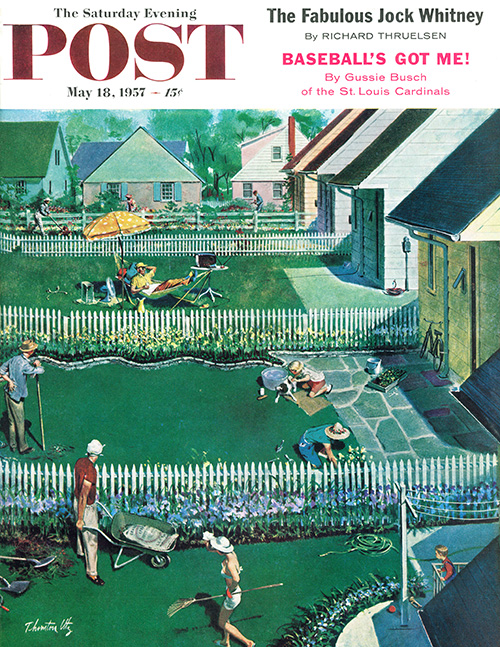
Thornton Utz
May 18, 1957
Thornton Utz, the artist who painted the above cover, has yet another option to yardwork. Just let the darn thing go. While industrious neighbors are raking, shoveling, planting, and so forth, Joe just sits back, communing with nature and catching the game on his portable TV. Well, communing with crabgrass. If you click on the cover for a close-up view, you’ll see he even has a fan rigged up to blow cool air from a large block of ice. Hey, when watching the game in living black and white, no comfort is overlooked.

George Hughes
September 27, 1952
“I’m all for free spirits,” thinks the blonde lady leaning out her window, “until one moves in next door!” What’s moving in next door is a big bass drum and tuba. What, you got something against music, lady?

Richard Sargent
February 5, 1955
Perhaps nosy blonde lady above can learn something from the kid down the street. Billy is not yet enamored by the sounds of the violin, but was told he has to practice an hour a day. According to the timer on the chair, he has so far gotten in about five minutes. The ear muffs should help.
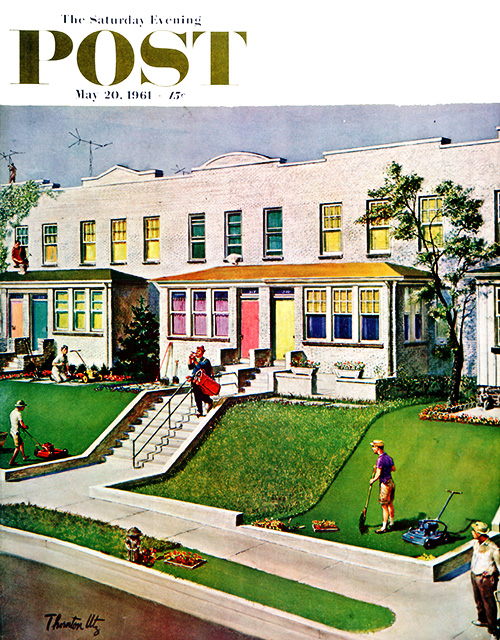
Thornton Utz
May 20, 1961
I’d Rather Be Golfing shows us a neighbor saying to heck with yardwork by, guess who? Yes, apparently cover artist Thornton Utz used much of his artistic creativity in devising ways to avoid lawn maintenance. One has to admire a man like that.

Richard Sargent
June 17, 1961
The water temperature is 50 degrees and even the lifeguard is bundled up. But there’s always one guy, isn’t there? Otherwise, there would be no need for a lifeguard on this nippy day. I’m thinking old Smiley here was the same kid who, just before the bell rang to dismiss class, would remind the teacher she hadn’t assigned homework yet.
Descriptions by Diana Denny.
Cover Collection: Baseball
From luminaries like Stan the Man and Yogi Berra, to kids playing sandlot ball, The Saturday Evening Post knew no equal when it came to great baseball covers.

John Falter
May 1, 1954
Not only did these St. Louis kids have to miss school (awww!), they had to sit and pose with Stan the Man Musial. What a rough life. The lucky youngsters wound up with forty Musial autographs. “Wow!” one said in awe. “Will we clean up selling these at school!” We’re sure at least one of them has wished he’d kept it.

Earl Mayan
April 20, 1957
Who doesn’t love Yogi Berra? Long before he became famous for maiming the English language, Berra was catcher for the New York Yankees. Artist Earl Mayan got him to pose in Yankee Stadium for this cover. Love the fan faces! The editors informed us they were friends of the artist and “were real nice-looking people till he asked them to look like baseball fans.”

John Falter
September 2, 1950
While we admire the pros, there’s nothing like a family baseball game. It’s 1950 and Uncle Baldy can’t decide whether to pitch or throw to Aunt Sally in the yellow dress on second base and catch the guy out. We have to say Aunt Martha’s batter’s stance is interesting. The editors speculated that the umpire was selected “because he has a natural chest protector”. Well, a natural belly protector, anyway.
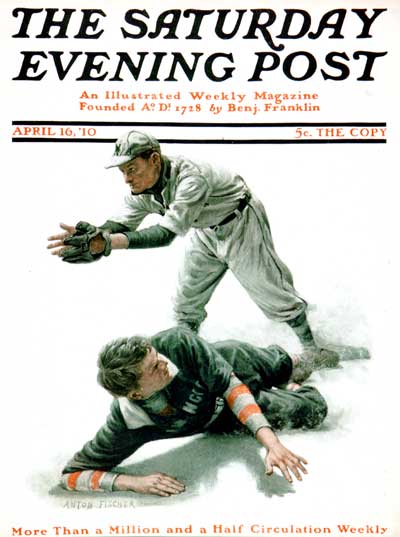
Anton Otto Fischer
April 16, 1910
It’s no surprise that they played baseball in 1910, as we see in this cover. What surprised us was the artist – none other than Anton Otto Fischer. Mostly famous for his masted ships rolling over foaming waves, Fischer also was great at painting people. This slice-of-landlubber-life captures the action perfectly. Interesting catcher’s mitt!

John Clymer
April 21, 1951
Artist John Clymer was known for his beautiful landscapes. Sure, he manages here to paint Oregon in all its spring glory, pink blooms, Mount Hood and all. But the eye is drawn here to the fine pitching form of Miss Pigtails and the concentration of the batter. The trees may be budding and the grass greening, but kids’ thoughts turn to baseball. It must be spring!
Descriptions by Diana Denny.
Vintage Ads: Polio, Pertussis, and Other Plagues
Diseases such as smallpox, typhoid, and polio used kill or injure thousands of people every year. These ads from drug and insurance companies encouraged people to make use of the new vaccines and antibiotics.

May 30, 1925
(Click to Enlarge)
Typhoid is a bacterial infection caused by consuming contaminated food or water. Two U.S. presidents — William Henry Harrison and Zachary Taylor — died of the disease. During the Civil War, 80,000 Union soldiers died of typhoid or dysentery, more than died in battle. After a vaccine was developed in the late 1800s, the entire U.S. Army was vaccinated, eliminating typhoid as a significant cause of death during World War I. Due to improved sanitation, typhoid is no longer a threat in the U.S., and people are advised to get vaccinated only if traveling to places where typhoid is common.
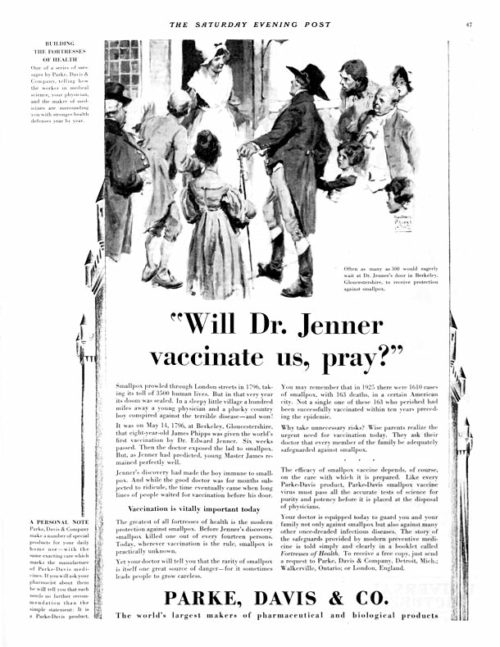
November 10, 1928
(Click to Enlarge)
Smallpox was the first vaccine to be developed, in 1796, and the disease was already on its way to being eliminated when this ad appeared in 1928. The World Health Organization led a massive campaign to eradicate smallpox in the 1960s, and it was wiped out worldwide by 1977. Routine vaccination in the U.S. ended in 1972, and now smallpox exists only in laboratories.

April 12, 1947
(Click to Enlarge)
The tuberculosis vaccine is the most widely used vaccine in the world; more than 90% of children are vaccinated. Unfortunately, tuberculosis continues to be a significant global problem. One-third of the world’s population is thought to be infected with latent or active tuberculosis. In 2016, there were 10 million cases of active infections and 1.3 million deaths. TB can be treated with antibiotics, but antibiotic reisistance is a growing problem.
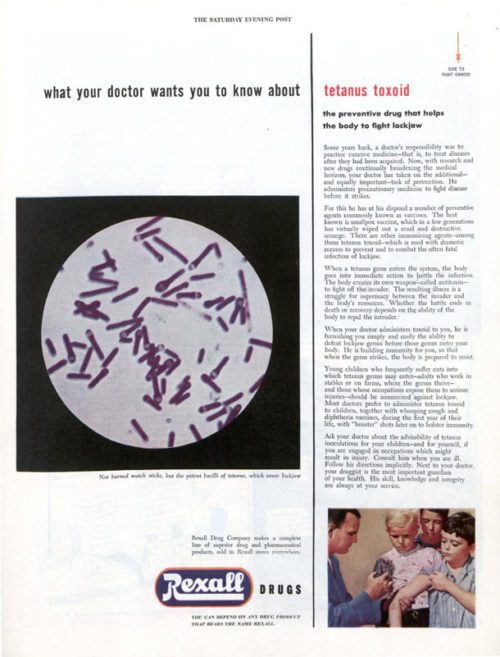
April 3, 1948
(Click to Enlarge)
Many remember being terrified of stepping on a rusty nail and getting “lockjaw,” the more colorful name for tetanus. Tetanus is an infection caused by bacteria found in soil, manure, and dust. The bacteria can cause severe muscle spasms, which usually start in the jaw. Because of the extreme potency of the tetanospasmin toxin, recovery from naturally acquired tetanus does not usually result in immunity. Luckily for barefooted explorers, there is a vaccine.

August 20, 1955
(Click to Enlarge)
This 1955 ad encourages parents to talk to their doctor about immunizations for smallpox, whooping cough, diptheria, and tetanus, also noting that “medical authorities now advise that vaccine lessens your child’s chance of getting polio.” The list of available vaccines has grown quite a bit longer since 1955; since then, immunizations have been developed for measles (1963), mumps (1967), rubella (1969), meningitis (1974), pneumonia (1977), yellow fever (1978), rabies (1980), hepatitis B (1981), Hib (1985), chicken pox (1995), shingles (2006), and HPV (2006).
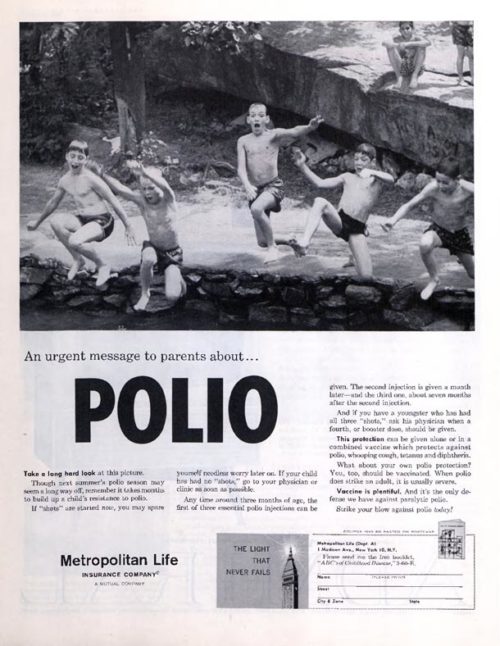
March 12, 1960
(Click to Enlarge)
Throughout the 20th century, Metropolitan Life ran a series of ads encouraging parents to vaccinate their children against polio, diptheria, whooping cough, and other childhood diseases. When this ad ran in 1960, the polio vaccine had only been in use for five years, but most people were eager to vaccinate: the 1952 polio epidemic was the worst outbreak in the nation’s history. Of the nearly 58,000 cases reported that year, 3,145 people died and 21,269 were left with mild to disabling paralysis.

November 16, 1963
(Click to Enlarge)
Scarlet Fever is an infection caused by the same bacteria that causes strep throat. Before the nineteenth century, it was considered a fairly bengin childhood disease, but it became more deadly in the 1800s. According to http://aetiologyblog.com, childhood fatality rates reached 30% in the U.S. and U.K. from 1840 to 1883. Children and their familities were quarantined for weeks to reduce the spread of the disease. Then, just as mysteriously, death rates declined. Between its reduced virulence and the introduction of antibiotics, scarlet fever became much less of a threat.

October 17, 1964
(Click to Enlarge)
The near-eradication of polio is one of medicine’s biggest success stories. Polio was officially eliminated from the U.S. in 1991. As of 2016, there were only 42 cases of polio in the world, down from 350,000 in 1988. Polio remains a stubborn problem in a handful of countries, where distribution of the vaccine has been thwarted because of war, remoteness, or suspicion.
American Cars: Selling the Dream
 Following World War II, with a booming economy, cheap gas, and a growing highway system, Americans were driving more miles every year, and buying more cars. In the 1950s, the iconic Cadillac tail fin became a symbol of prosperity, and it continued to grow until, in 1959, it was over a foot high. The ’60s would usher in the muscle cars. Inspired by the success of the 1965 Ford Mustang, we soon had GM’s powerful GTO and plenty more like it. Here is a sampling of the sumptuous and seductive mid-century automotive ads that helped sell those cars, selected from our new special collector’s edition, American Cars: 1940s, ’50s & ’60s.
Following World War II, with a booming economy, cheap gas, and a growing highway system, Americans were driving more miles every year, and buying more cars. In the 1950s, the iconic Cadillac tail fin became a symbol of prosperity, and it continued to grow until, in 1959, it was over a foot high. The ’60s would usher in the muscle cars. Inspired by the success of the 1965 Ford Mustang, we soon had GM’s powerful GTO and plenty more like it. Here is a sampling of the sumptuous and seductive mid-century automotive ads that helped sell those cars, selected from our new special collector’s edition, American Cars: 1940s, ’50s & ’60s.
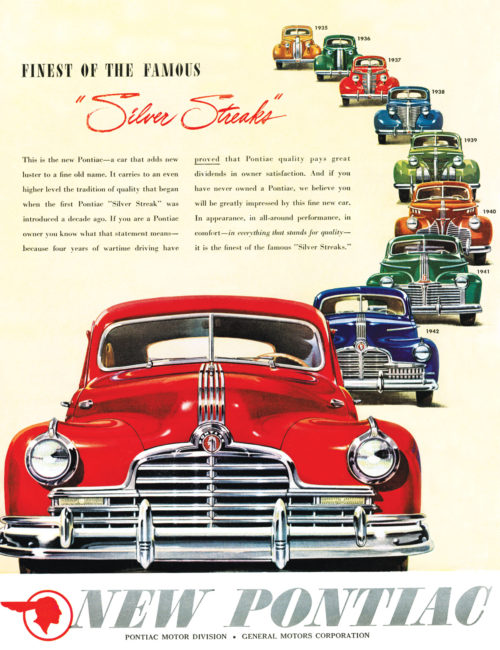


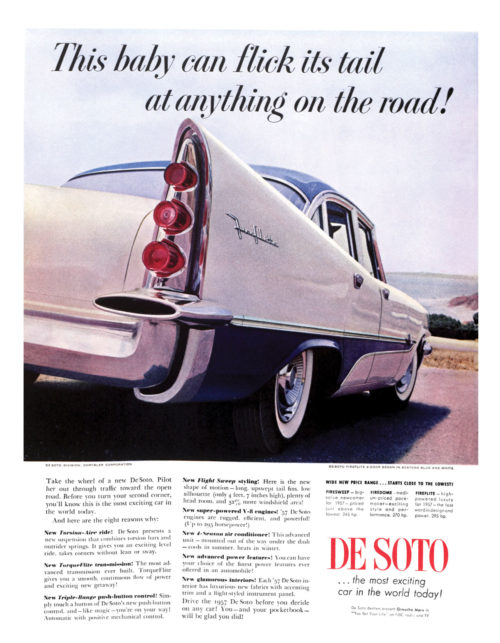


Cover Collection: Tremendous Trains
Whether you’re a die-hard train buff, a transportation geek, or merely a weary commuter, trains have long played a major role in American life. These covers — from as early as 1901 — reflect our love affair with locomotives.

Thornton Utz
October 20, 1951
The top panel of this painting by Thornton Utz shows a well-dressed group of commuters waiting for the Empire Express. Notice the lady in red on the near left with her caged canary. Scene Two: Skirts and hats are flying as the Express roars by. The poor kid on in the letter sweater crashes into the birdcage. The third panel shows a disheveled lot, to say the least. Do you see what happened to the befuddled canary?

J.J. Gould
January 16, 1904
Train buffs love this turn-of-the-century railroad engineer. Standing by the mighty mechanical monster he conducts, he poses for artist J.J. Gould.

George Gibbs
January 26, 1901
As far back as 1901, trains have graced our covers. Horseless carriages, ships and trains – what will they think of next? A cityscape in the background completes this bow to modernity. The quote below the cover art says: “Bowing respectfully to the past, and rendering justice to the present, we salute the future and true progress. – Montalembert”.
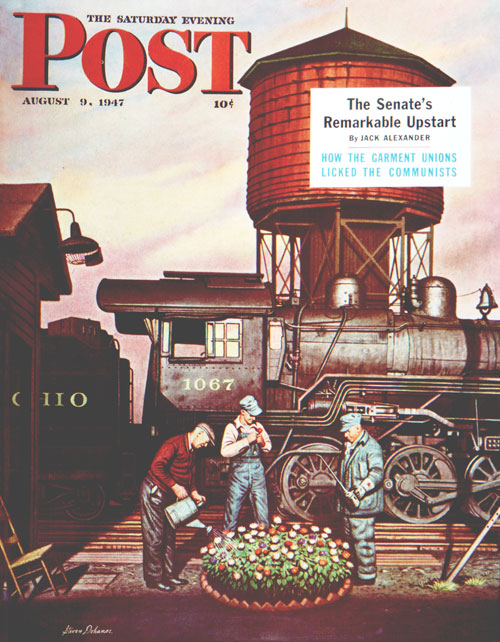
Stevan Dohanos
August 9, 1947
We love this cover by artist Stevan Dohanos from 1947. The editors noted that the artist had actually worked on the Baltimore and Ohio Railroad for a few years. “He checked loads and tracks, beginning a ten-mile hike at 6:30 every morning. He came to think highly of the switchyard men, because in their shacks he could get warm.” Dohanos painted this in his hometown of Lorain, Ohio.

John Falter
May 4, 1957
John Falter, when a child, used to listen to freight trains chugging up a nearby hill and worry about whether they’d make it. Our scene is Missouri, the Missouri River and Kansas beyond. This time we are in Missouri, looking at Kansas in the distance. This time the kids are waving clear across the river to the train. Or maybe they just know somebody in Kansas to wave to.

John Falter.
June 22, 1946
Artist John Falter did 129 Post covers, and this is a good example of why. Belching smoke along the mighty Missouri River, this steam engine doesn’t warrant a glance from the boys walking by. They also are probably unaware they are using a route once used by Lewis and Clark. You are in Kansas, looking over into Missouri in this one.
Descriptions by Diana Denny.
The Art of the Post: The Saddest Cover
My candidate for the saddest cover of the Post is this painting by Gilbert Bundy of a WAC looking over her shoulder at a frivolous hat in a store window.

The determined WAC is headed off to do her duty. Her thoughtful expression suggests she’s a little wistful about the pretty things she is leaving behind. But what makes that so tragic?
The artist, Gilbert Bundy, earned fame in the 1930s for his light-hearted watercolor cartoons of beautiful women in high society scenes.

He seemed to take particular pleasure in painting floral arrangements:

Photos from the social pages of the time show the handsome young illustrator at parties, dressed in his tuxedo and escorting lovely young socialites. Here we see him in his studio painting one of his elegant models:
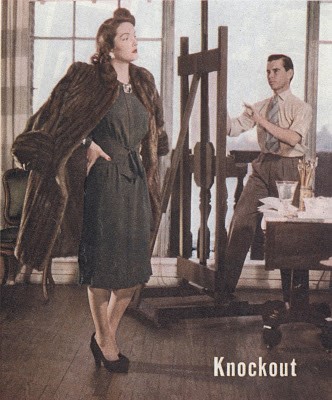
His charmed life continued as he fell in love, married, and had a baby daughter. The future looked good.
But when World War II began, the stakes changed. We can’t know exactly what was going through Bundy’s mind as he painted that cover for the Post. All we know is that, like the WAC in his painting, Bundy decided to abandon his civilian life painting pretty girls and go to war. He volunteered to work as a war artist covering the South Pacific for Hearst newspapers.

In 1944, Bundy was participating in the Marine invasion of the island of Tarawa when a Japanese shell exploded in his small landing craft. Bundy awoke to find himself trapped beneath the bodies of four Marines. The wreckage of the craft had drifted onto a coral reef within range of enemy gunners on the island. For most of that long day, Bundy remained pinned beneath corpses and drenched with blood, as enemy bullets and shells strafed the remnants of the craft. When night came, Bundy managed to free himself and swam away from the wreck, taking his chances spending a night alone in shark infested waters rather than endure another day under enemy fire.
The Hearst newspaper reported, “He was believed dead for three days. His reappearance startled his Marine mates.”
Bundy was shipped back to the U.S. where he tried to return to his previous life. He painted a series of illustrations of light-hearted romantic stories for the Post.

For the story, “Good Time Girl” by Lester Atwell, which appeared in the Post on January 31, 1948, Bundy painted a woman in a fur coat standing in front of a three-way mirror. After a couple of unsatisfactory attempts, he decided to paint the woman three times: “I finally posed my model backward or sidewise in three separate poses, one for each panel of the mirror, and worked direct. Then I combined the three to get the triple-reflection effect.”

His challenge, Bundy reported, was painting a pair of beautiful legs from three different angles. Who could ask for a more fun job?
But beneath the surface Bundy remained haunted by his wartime experience.
On the anniversary of his ordeal, Bundy committed suicide and rejoined his fallen comrades.
In hindsight, his Post cover about the WAC has a tragic air. The WAC was taking a last lingering look at civilian pleasures as she responded to the call of duty. Whatever was going through Bundy’s mind as he painted, he couldn’t know what horrors lay in store for him. His refined fingers, so well suited for painting delicate pictures of flowers and shapely girls, were not well suited for clawing their way out from under corpses.
Comparing his illustrations before and after the war, we see that his art lost much of its confidence and certainty. Gone was the joyful exuberance. His deft brush strokes became labored and heavy handed. His pictures—like his life—seemed to lose their balance and proportion.
If you or a loved one is struggling with thoughts of suicide, you’re not alone. Call the National Suicide Prevention Lifeline at 1-800-273-8255.
Happy 100th Birthday, Mr. Peanut
It’s appropriate that the Post acknowledges Mr. Peanut this February 23. After all, his national ad campaign was launched in our magazine exactly 100 years ago with the page below.
He was the product of a contest held by the Planter’s Nut and Chocolate Company. They offered a $5 prize for the best idea for a new trademark. The winning idea, created by a 14-year-old boy, was further developed by the company, which wanted to present Planter’s as a higher class of nut. So they added aristocratic touches to his minimal wardrobe: a top hat, spats, and monocle.
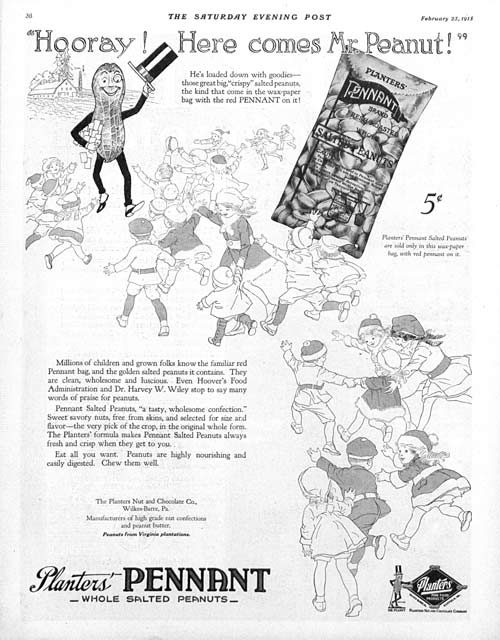
This article is featured in the January/February 2018 issue of The Saturday Evening Post. Subscribe to the magazine for more art, inspiring stories, fiction, humor, and features from our archives.
Vintage Ads: Uneeda Biscuit Takes Crackers Out of the Barrel
Back in the 1800s, crackers were sold in bulk in open barrels in general stores. They were frequently stale by the time they were purchased. Then, in the 1890s, Adolphus Green created the National Biscuit Company and developed a lighter, flakier cracker that would stay crisper longer, thanks to a nearly airtight package. A liner using interfolded wax paper and cardboard kept out moisture and prevented the crackers from losing their crunch. To emphasize this feature, the company created a mascot: a boy in a rain slicker, usually shown in a downpour, carrying a box of Uneeda Biscuits.
By 1904, when this full-page ad appeared in the Post, that boy would have been a familiar sight to readers. They’d already been subjected to the company’s $7 million advertising campaign, the first to introduce a new product to the entire nation. It had been so successful that Uneeda ads didn’t have to bother using copy to sing the praises of the cracker. The National Biscuit Company, soon to be known as Nabisco, simply showed the familiar mascot.

This article appears in “The Vault” section of the March/April 2018 issue of The Saturday Evening Post. Subscribe to the magazine for more art, inspiring stories, fiction, humor, and features from our archives.
Norman Rockwell Goes to the Dogs
Norman Rockwell loved his dogs, and many of them ended up on the covers of the Post. Here are some of our favorite furry friends.

September 28, 1929
One of the dogs on this September 29, 1929 cover was a Rockwell family pet preparing for travel. Would that be the one with the “R” around his neck? It would indeed be Raleigh Rockwell. Maybe Rockwell scrounged up the other mutt from around the neighborhood. Perhaps the boy as well.

Norman Rockwell
November 7, 1931
Music is in the ear of the beholder. It would appear that the mutt on the 1931 cover has more of an ear for music than the trumpeter. The cover is called “Practice Makes Perfect,” but from the look on the dog’s adorable face, there is a long way to go. The bag of potatoes? The “music man” was taking a break from his grocery job for practice.
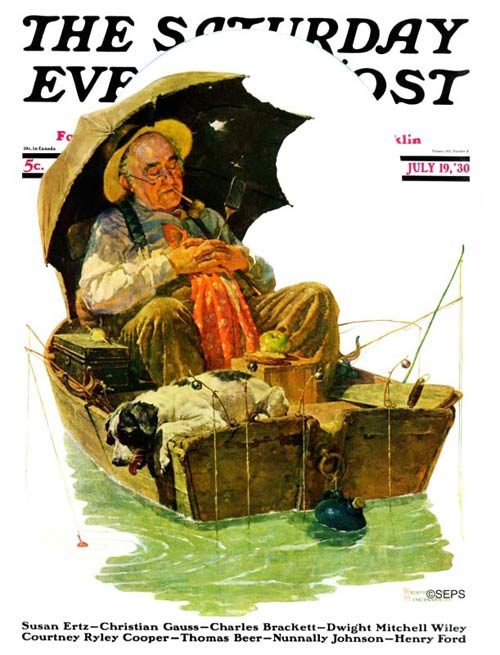
Norman Rockwell
July 19, 1930
Grandpa can snooze away a sunny day, but never fear. Fido is watching carefully to see if there’s a tug on the line. We think we know who the fisherman in the family is on this 1930 cover. Note the jug of cider staying cool in the water.
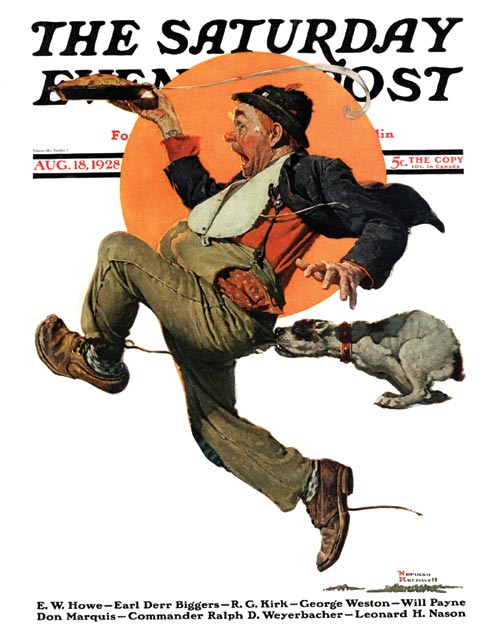
August 18, 1928
A hobo in 1928 is not faring so well. A family dog caught him stealing a pie, presumably left on a windowsill to cool. Rover is nipping him right where it counts. Love the polka-dot socks.

Norman Rockwell
September 27, 1924
An irresistible cover is “Pals” from 1924. Hobos were a popular theme in the 1920’s and while this gentleman may be down and out, he’s certainly somebody special to this dog. Admit it, it kind of brings a tear to your eye, doesn’t it?

Norman Rockwell
October 2, 1937
But alas, dogs will be dogs, as Rockwell shows us in the October 2, 1937 cover. A worker has painted a perfect white line on the street. At least until a rambunctious dog chases an unfortunate cat across the fresh paint. Ah, well, all in a day’s work.